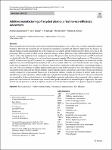Search
Author
- Heshan, Jayawardane (1)
- Ian J., Davies (1)
- J. Cea, Carrasco J. C. (1)
- J. R., Gamage (1)
- next >
Subject
- PEG (1)
- PLA material (1)
Date issued
Has File(s)
- true (2)
Search Results
Plastic materials have been widely used to replace metals in functional parts due to their lower cost and comparable technical properties. However, the increasing use of virgin plastic material in consumer and industrial applications has placed a significant burden on waste management due to the volume of waste created and the potential negative effects of its end-of-life processing. There is a need to adopt circular economy strategies such as plastic recycling within industrial applications in order to reduce this significant waste management pressure. The present study used recycled polylactic acid (PLA) material as a feedstock for the 3D printing of a centrifugal semi-open pump impeller. The technical performance of 3D printed recycled PLA material and virgin PLA material was com... |
In this study, bionanocomposite films based on poly(lactide) (PLA) plasticised with poly(ethylene glycol) (PEG) (7.5 wt%) and reinforced with various contents of nanofibrillated cellulose (NFC) (1, 3, 5 wt%) were prepared. The hydrothermal degradation was investigated through immersion in several aqueous environments at temperatures of 8, 23, 58, and 70 °C as a function of time (7, 15, 30, 60, 90 days). The effect of water immersion on the physicochemical properties of the materials was assessed by monitoring the changes in the morphology, thermo-oxidative stability, thermal properties, and molar mass through field emission scanning electron microscopy (FE-SEM), thermogravimetric analysis (TGA), differential scanning calorimetry (DSC), and gel permeation chromatography (GPC). |


